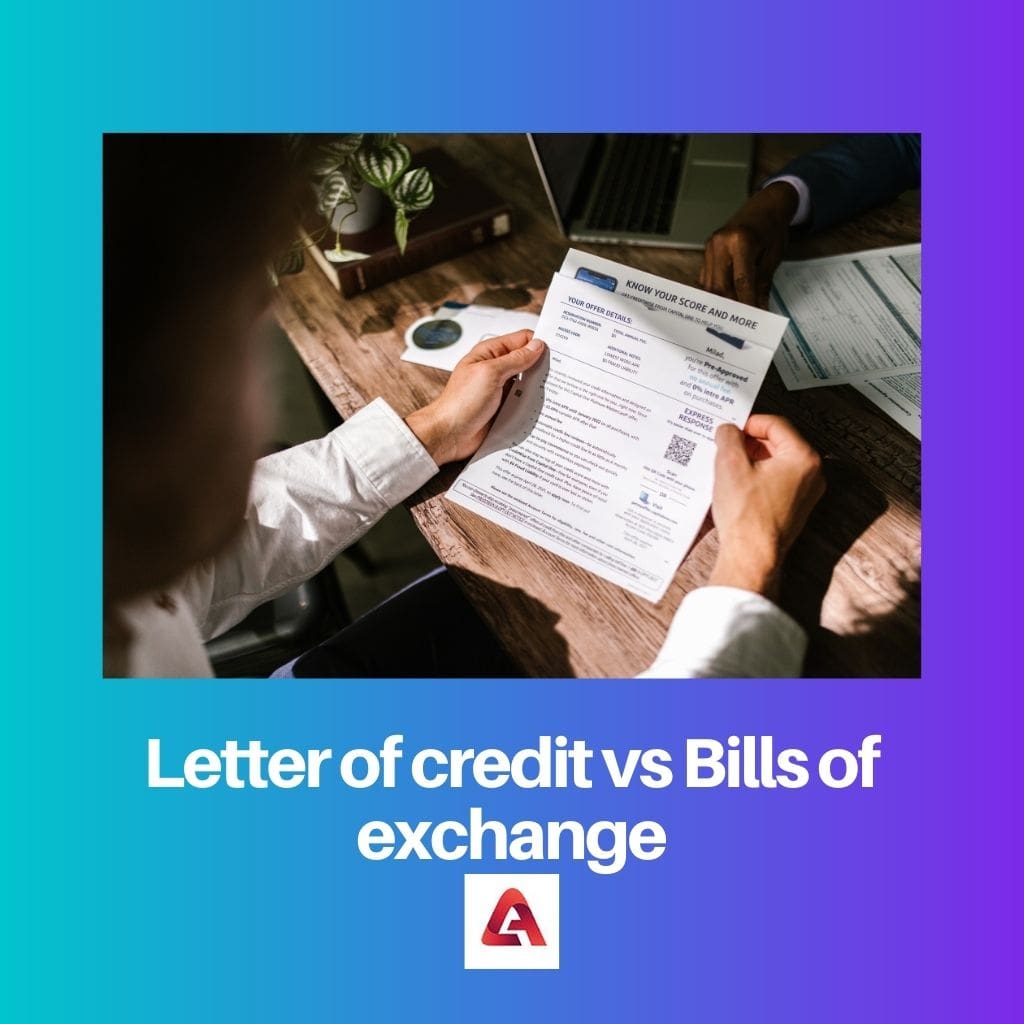A Letter of Credit (LC) is a financial document issued by a bank, guaranteeing payment to a seller upon presentation of specified documents, ensuring a secure international trade transaction. On the other hand, a Bill of Exchange is a written order from the seller to the buyer, directing the buyer to pay a specific amount to the seller at a future date, serving as a negotiable instrument in commercial transactions.
Key Takeaways
- A letter of credit is a financial instrument issued by a bank, guaranteeing payment to a seller on behalf of a buyer, provided certain conditions are met.
- A bill of exchange is a written order in which one party directs another party to pay a specified sum of money to a third party at a future date.
- Letters of credit are used to facilitate international trade by reducing risk for both parties, while bills of exchange are negotiable instruments used for short-term financing and credit transactions.
Letter of Credit vs Bills of Exchange
The difference between a letter of credit and a bill of exchange is that a Letter of credit focus on the payment mechanism, and a bill of sale are nothing other than a payment instrument.

Comparison Table
| Feature | Letter of Credit | Bill of Exchange |
|---|---|---|
| Function | Payment mechanism | Payment instrument |
| Number of Parties | Four: Buyer, Seller, Issuing Bank, Advising Bank (optional) | Two or Three: Drawer (initiator), Drawee (payer), Payee (recipient) |
| Guarantee | Provides a guarantee of payment from the buyer’s bank to the seller’s bank upon fulfillment of conditions | No guarantee of payment, relies on creditworthiness of drawee |
| Risk | Lower risk for seller, higher risk for buyer’s bank | Higher risk for seller, lower risk for buyer |
| Cost | More expensive due to bank involvement | Less expensive |
| Suitability | High-value international transactions, situations with high risk of non-payment | Domestic transactions, lower value international transactions |
| Transferability | Not transferable | Can be transferred (negotiable) to a third party |
What is Letter of Credit?
Types of Letters of Credit
1. Revocable Letter of Credit
- Can be modified or canceled by the issuing bank without prior notice to the beneficiary.
- Rarely used in international trade due to the lack of security for the seller.
2. Irrevocable Letter of Credit
- Provides a higher level of security for the seller.
- Cannot be modified or canceled without the agreement of all parties involved.
3. Confirmed Letter of Credit
- Involves a second bank (confirming bank) that adds its confirmation to the LC, further assuring payment to the beneficiary.
- Commonly used when there are concerns about the creditworthiness of the issuing bank.
4. Transferable Letter of Credit
- Allows the beneficiary to transfer the credit to another party, typically used in complex trading scenarios.
5. Standby Letter of Credit
- Serves as a secondary payment mechanism if the buyer fails to fulfill their payment obligations.
- Commonly used in construction projects and other business contracts.
Key Parties in a Letter of Credit Transaction
1. Applicant
- The buyer or importer who requests the issuance of the LC.
2. Beneficiary
- The seller or exporter who receives the LC and is assured of payment.
3. Issuing Bank
- The bank that issues the LC on behalf of the buyer.
4. Advising Bank
- The bank that advises the beneficiary about the LC’s authenticity and terms.
5. Confirming Bank
- If applicable, the bank that adds its confirmation to the LC.
6. Negotiating Bank
- The bank that pays the beneficiary upon presentation of compliant documents.
Letter of Credit Process
- Issuance: The buyer applies for an LC from their bank (issuing bank).
- Advising: The LC is transmitted to the beneficiary through an advising bank in the seller’s country.
- Confirmation: If required, the advising bank may confirm the LC, providing additional assurance to the beneficiary.
- Shipment and Documents: The seller ships the goods and prepares the necessary documents as specified in the LC.
- Presentation: The beneficiary presents the compliant documents to the negotiating bank.
- Payment: The negotiating bank pays the beneficiary, and the documents are forwarded to the issuing bank.
- Payment to Issuing Bank: The issuing bank reimburses the negotiating bank, and the buyer settles the payment with their bank.
Advantages of Using Letters of Credit
1. Risk Mitigation
- Provides a secure payment method, reducing the risk of non-payment for the seller.
2. International Trade Facilitation
- Enables smooth and efficient cross-border transactions.
3. Creditworthiness Assurance
- Enhances the buyer’s credibility by demonstrating financial commitment through the LC.
4. Flexibility
- Can be tailored to meet the specific needs of the buyer and seller.
Challenges and Considerations
1. Costs
- The process involves fees and charges, impacting the overall transaction cost.
2. Complexity
- Understanding and navigating the intricacies of LCs can be challenging for parties involved.
3. Time Consumption
- The process may take time, affecting the speed of the transaction.
4. Documentary Compliance
- Strict adherence to document requirements is crucial for successful transactions.

What is Bills of Exchange?
Key Parties Involved
Drawer
The drawer is the party initiating the bill. This entity creates the document, specifying the payment details and designating the drawee.
Drawee
The drawee is the party upon whom the bill is drawn. This is typically the debtor or the party responsible for making the payment as specified in the bill.
Payee
The payee is the entity to whom the payment is to be made. This can be the drawer or a third party, depending on the agreement.
Characteristics
Negotiability
One crucial feature of bills of exchange is their negotiability. They can be transferred from one party to another, enabling flexibility in payment arrangements.
Maturity Date
Bills of exchange have a predetermined maturity date, indicating when the payment is due. This date is agreed upon by the parties involved and is a crucial aspect of the document.
Acceptance
The drawee may need to formally accept the bill, indicating their commitment to make the payment on the specified date. This step adds a layer of security for the drawer.
Types of Bills of Exchange
Sight Bill
In a sight bill, the payment is due upon presentation. The drawee is required to pay immediately upon receiving the bill.
Time Bill
A time bill specifies a future date for payment. The drawee is obligated to make the payment on or after the maturity date mentioned in the bill.
Documentary Bill
A documentary bill involves the presentation of supporting documents, such as shipping or title documents, before the payment is made. This adds an extra layer of security for both parties.
Advantages
Facilitates Trade
Bills of exchange facilitate international and domestic trade by providing a secure and widely accepted method of payment.
Credit Instrument
They serve as credit instruments, allowing businesses to defer payments or negotiate favorable terms.
Transferability
The negotiability of bills allows for easy transfer, making them a versatile tool in financial transactions.
Risks and Considerations
Non-Acceptance or Non-Payment
There is a risk of non-acceptance or non-payment by the drawee, which may result in financial losses for the drawer.
Documentary Compliance
In the case of documentary bills, ensuring compliance with the specified documents is crucial to avoid disputes.

Main Differences Between Letter of Credit and Bills of Exchange
- Nature:
- Letter of Credit (LC): It is a financial instrument issued by a bank on behalf of a buyer, ensuring that the seller receives payment upon meeting certain conditions specified in the LC.
- Bill of Exchange (BoE): It is a written order from the exporter (drawer) to the importer (drawee) to pay a specified sum of money at a future date.
- Parties Involved:
- LC: Involves three parties – the buyer (applicant), the seller (beneficiary), and the issuing bank.
- BoE: Involves two parties – the drawer (seller/exporter) and the drawee (buyer/importer).
- Role of Banks:
- LC: The bank plays a crucial role by guaranteeing payment to the seller once the required documents are presented, ensuring security for both parties.
- BoE: Banks may be involved in the collection process but do not provide the same level of payment guarantee as in an LC.
- Payment Guarantee:
- LC: Offers a higher level of payment security for the seller, as the bank’s commitment is independent of the buyer’s financial standing.
- BoE: The payment depends on the creditworthiness of the buyer, and there is no direct bank guarantee.
- Flexibility:
- LC: More rigid, as the terms and conditions are set by the issuing bank, and any changes require the consent of all parties involved.
- BoE: More flexible, allowing for negotiation of terms between the buyer and seller.
- Usage:
- LC: Commonly used in international trade to mitigate risks for both the buyer and seller.
- BoE: Used in domestic and international trade but involves a higher level of trust between the parties.
- Documentary Requirements:
- LC: Involves a set of documents specified in the LC that the seller must present to receive payment.
- BoE: Less document-intensive, usually requiring only the BoE itself.
- Financing:
- LC: Can be used as a financing tool, allowing the seller to obtain funds from the bank before shipping the goods.
- BoE: May not offer the same level of pre-shipment financing as an LC.
- Risk Allocation:
- LC: Shifts the risk from the buyer to the bank, providing a more secure transaction.
- BoE: Involves a higher degree of risk for the seller, as payment depends on the buyer’s willingness and ability to pay.
- Independence:
- LC: Operates independently of the underlying sales contract and the buyer’s financial situation.
- BoE: Linked directly to the sales contract and the creditworthiness of the buyer.

- https://papers.ssrn.com/sol3/papers.cfm?abstract_id=151849
- https://cbr.cba.org/index.php/cbr/article/download/2486/2486/
- https://digitalcommons.nyls.edu/cgi/viewcontent.cgi?article=1059&context=journal_of_international_and_comparative_law